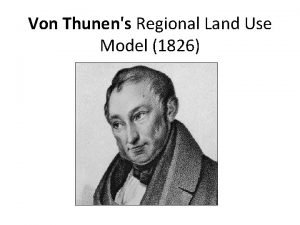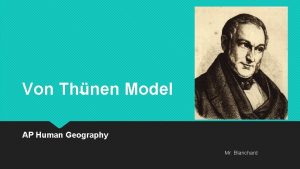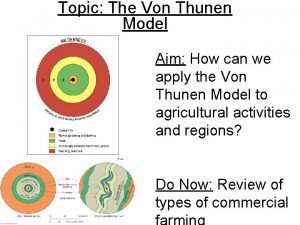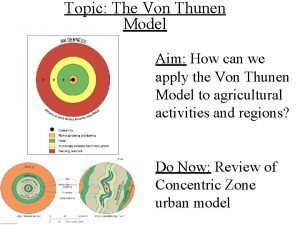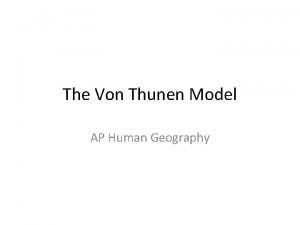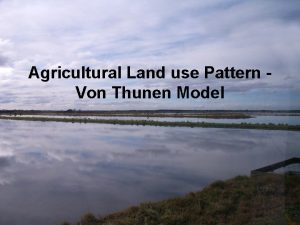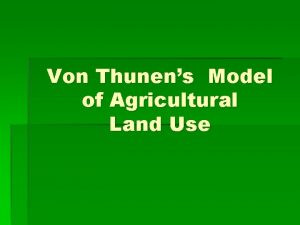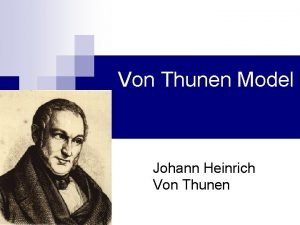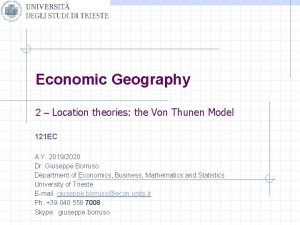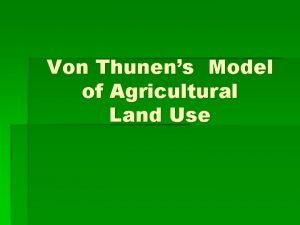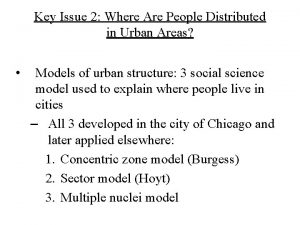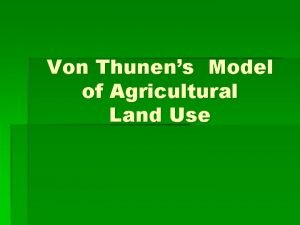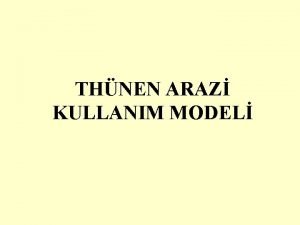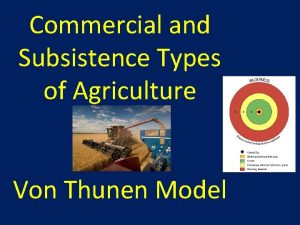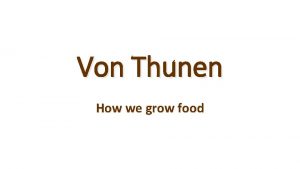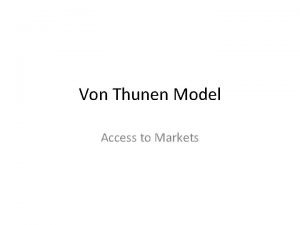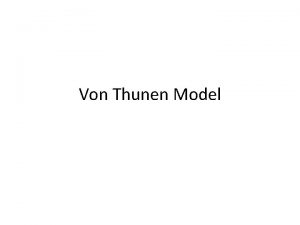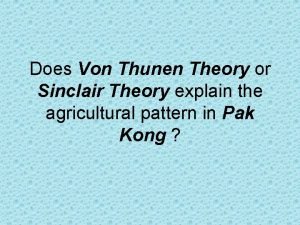Ch 10 Agriculture Von Thunen Model Review What













- Slides: 13

Ch. 10 Agriculture Von Thunen Model

Review: What is a model? • Models are examples that help us better understand a major concept or idea. • Models are NOT exact and are flexible. • Models are NOT perfect. • Models might look different in reality than the do in theory.

Historical Background • “A Portion of Each Crop is Eaten By the Wheels!”- von Thunen. • • Germany, 1820’s. Developed by Johann Heinrich von Thunen in the early 1800’s (19 th century) Based on the layout of Rostock, Germany Noticed a pattern of 4 rings developed around the central city. – Each ring was a different type of agriculture. Created before highways, railroads, factories, etc.

Von Thunen’s Model of Agricultural Land Use The first location theory A concentric model

The 6 Assumptions 1. There is only one market available, self-sufficient with no outside 2. 3. 4. 5. 6. influence. All farmers are market oriented, producing goods for sale. (Not subsistence. ) The physical environment is uniform; there are no rivers or mountains. All points at equal distances from the market have equal access to the market. All farmers act to maximize profits. The dietary preferences of the population are those of Germanic Europeans.

Land Rent • The main concept is land rent or land value, which will decrease as one gets farther away from central markets. • Rent is highest in the closest proximity to urban markets. (Bid-Rent Theory) • Thus, agricultural products that have intensive land use, have high transportation costs and were in great demand would be located close to urban markets.

Bid-Rent Curve • As distance from city center increases, cost of land goes down.

The Formula • Profit = Market Price – Production Costs • Production costs include cost of labor, equipment, and • • TRANSPORTATION! Factor 1: The bulkier the product, the more it costs to transport. Factor 2: The more perishable a product, the closer to the market it has to be. Factor 3: The more land a product needs, the farther from the central city it should be (land closer to city is more expensive) All of these must be considered when deciding what to grow where!

The Rings • Ring 1: Dairy/ Commercial Gardening • • • Not as heavy as wood, can be stored for longer periods of time. Ring 4: Livestock • • • Not perishable but very heavy! Ring 3: Extensive Crops (grains) • • Located too far, goods go bad, no profit Ring 2: Forest (building material/ fuel) • • Easily perishable goods Needs a lot of land Perishable once slaughtered, but animals can transport themselves! Beyond the rings: Wilderness • Too far from city, to expensive to transport anything.

So…. 1. Dairying and gardening of fruits and vegetables would be closer to the urban market while… 2. Timber and firewood for fuel and building materials would be in the second zone. 3. Mixed farming, commercial grain and orchards and 4. Extensive cattle ranching would be located farther away. Transportation is cheap: the animals can walk to the city for butchering.

Some products spoiled more quickly, needed more sensitive transportation, or generate higher prices at market These products mean the farmer can afford higher land rent.

A different way to look at it…

 Von thunen frq
Von thunen frq Von thunen model ap human geography
Von thunen model ap human geography Von thunen ring
Von thunen ring Von thunen model rings explained
Von thunen model rings explained Von thunen model ap human geography definition
Von thunen model ap human geography definition Von thunen agricultural land use model
Von thunen agricultural land use model Von thunen 6 assumptions
Von thunen 6 assumptions Bid-rent theory
Bid-rent theory Industrial location theories and models
Industrial location theories and models Assumptions of the von thunen model
Assumptions of the von thunen model Concentric zone
Concentric zone Thunens model
Thunens model Thünen modeli
Thünen modeli Teori von thunen
Teori von thunen
